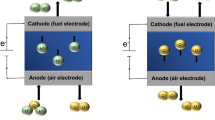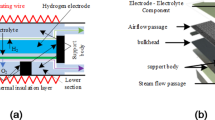Abstract
Solid oxide cells (SOCs) efficiently interconvert chemicals and electricity. However, they are primarily confined to 2D design and fabrication technologies. Planar SOC stacks require complex multi-material components, leading to reduced compactness and high specific weight. Here we escape the 2D paradigm and adopt a true 3D design based on triply periodic minimal surface structures, enabling superior performance on gravimetric and volumetric bases. Leveraging the resolution and accuracy of additive manufacturing, we demonstrate a monolithic, gyroidal SOC that eliminates the need for metallic interconnects and sealing components. The monolith achieves optimal spatial utilization, exceptional mass-specific indexes, a straightforward manufacturing procedure and high electrochemical and thermomechanical stability. The specific power and volumetric power density surpass 1 W g−1 and 3 W cm−3 in fuel cell mode, and the mass-index and volume-index hydrogen production rates are about 7 × 10−4 Nm3 h−1 g−1 and 2 × 10−3 Nm3 h−1 cm−3 in electrolysis mode, nearly an order of magnitude enhancement compared to planar stacks.
This is a preview of subscription content, access via your institution
Access options
Access Nature and 54 other Nature Portfolio journals
Get Nature+, our best-value online-access subscription
$32.99 / 30 days
cancel any time
Subscribe to this journal
Receive 12 digital issues and online access to articles
$119.00 per year
only $9.92 per issue
Buy this article
- Purchase on SpringerLink
- Instant access to full article PDF
Prices may be subject to local taxes which are calculated during checkout





Similar content being viewed by others
Data availability
All relevant data for this work can be found in the paper and Supplementary Information. A detailed overview of the data and plots are available at https://doi.org/10.11583/DTU.28153061. Source data are provided with this paper.
References
Hauch, A. et al. Recent advances in solid oxide cell technology for electrolysis. Science 370, eaba6118 (2020).
Wachsman, E. D. & Lee, K. T. Lowering the temperature of solid oxide fuel cells. Science 334, 935–939 (2011).
Guan, D. et al. Hydrogen society: from present to future. Energy Environ. Sci. 16, 4926–4943 (2023).
Abdelkareem, M. A. et al. On the technical challenges affecting the performance of direct internal reforming biogas solid oxide fuel cells. Renew. Sustain. Energy Rev. 101, 361–375 (2019).
Wachsman, E. D., Marlowe, C. A. & Lee, K. T. Role of solid oxide fuel cells in a balanced energy strategy. Energy Environ. Sci. 5, 5498–5509 (2012).
Hecht, M. et al. Mars Oxygen ISRU Experiment (MOXIE). Space Sci. Rev. 217, 9 (2021).
Cable, T. L. & Sofie, S. W. A symmetrical, planar SOFC design for NASA’s high specific power density requirements. J. Power Sources 174, 221–227 (2007).
Hoffman, J. A. et al. Mars Oxygen ISRU Experiment (MOXIE)—preparing for human Mars exploration. Sci. Adv. 8, eabp8636 (2022).
ElcoStack E3000 (fuel cell). Elcogen https://elcogen.com/products/solid-oxide-stacks-for-fuel-cell-systems/ (2024).
Lentatek solid oxide fuel cell (SOFC) stack. Lentatek https://www.lentatek.com/en/solutions/hydrogen-and-fuel-cell-technologies (2024).
Wobogroup SOFC stacks. Wobogroup https://wobogroup.en.made-in-china.com/product/OJCpGYjynLrX/China-Fuel-Cells-100kw-High-Efficiency-Solid-Oxide-Fuel-Cell-Stack.html (2024).
E&KOA SOFC stack, solid oxide fuel cell stack AERIE 120 (4kW). Hyfindr https://hyfindr.com/en/shop/products/solid-oxide-fuel-cell-stack-aerie-120 (2024).
Kyocera SOFC stack. Kyocera https://global.kyocera.com/prdct/ecd/sofc/ (2024).
Hayashi, K., Yokoo, M., Yoshida, Y. & Arai, H. Solid oxide fuel cell stack with high electrical efficiency. NTT Tech. Rev. 7, 14–18 (2009).
De Bruijn, F. The current status of fuel cell technology for mobile and stationary applications. Green Chem. 7, 132–150 (2005).
Singhal, S. C. Solid oxide fuel cells for stationary, mobile, and military applications. Solid State Ion. 152-153, 405–410 (2002).
Boldrin, P. & Brandon, N. P. Progress and outlook for solid oxide fuel cells for transportation applications. Nat. Catal. 2, 571–577 (2019).
Du, Y. & Finnerty, C. Tubular electrochemical cell. US patent 8,182,959 B2 (2012).
Tietz, F., Buchkremer, H. P. & Stöver, D. Components manufacturing for solid oxide fuel cells. Solid State Ion. 152-153, 373–381 (2002).
Tarancón, A. et al. 2022 roadmap on 3D printing for energy. J. Phys. Energy 4, 011501 (2022).
Maines, E. M., Porwal, M. K., Ellison, C. J. & Reineke, T. M. Sustainable advances in SLA/DLP 3D printing materials and processes. Green. Chem. 23, 6863–6897 (2021).
Ribó, M. N. Vat Photopolymerization Process Chain. PhD thesis, Technical University of Denmark (2020).
Yuan, J. et al. 3D printing of robust 8YSZ electrolytes with a hyperfine structure for solid oxide fuel cells. ACS Appl. Energy Mater. 6, 4133–4143 (2023).
Jia, K. et al. A new and simple way to prepare monolithic solid oxide fuel cell stack by stereolithography 3D printing technology using 8 mol% yttria stabilized zirconia photocurable slurry. J. Eur. Ceram. Soc. 42, 4275–4285 (2022).
Martos, A. M. et al. 3D printing of reversible solid oxide cell stacks for efficient hydrogen production and power generation. J. Power Sources 609, 234704 (2024).
Minh, N. Q. Ceramic fuel cells. J. Am. Ceram. Soc. 76, 563–588 (1993).
Schoen, A. H. Infinite periodic minimal surfaces without self-intersections (NASA, 1970); https://ntrs.nasa.gov/citations/19700020472
Fischer, W. & Koch, E. On 3-periodic minimal surfaces. Z. Kristallogr. Cryst. Mater. 179, 2031–2052 (1987).
Werner, J., Rodríguez-Calero, G., Abruña, H. & Wiesner, U. Block copolymer derived 3-D interpenetrating multifunctional gyroidal nanohybrids for electrical energy storage. Energy Environ. Sci. 11, 1261–1270 (2018).
Maurel, A. et al. Toward high resolution 3D printing of shape-conformable batteries via vat photopolymerization: review and perspective. IEEE Access 9, 140654–140666 (2021).
Dixit, T., Al-Hajri, E., Paul, M. C., Nithiarasu, P. & Kumar, S. High performance, microarchitected, compact heat exchanger enabled by 3D printing. Appl. Therm. Eng. 210, 118339 (2022).
Pesce, A. et al. 3D printing the next generation of enhanced solid oxide fuel and electrolysis cells. J. Mater. Chem. A 8, 16926–16932 (2020).
Trussler, S. Placement of reference electrode, electrolyte thickness and three-electrode cell configuration in solid oxide fuel cells: a brief review and update on experimental approach. J. Electrochem. Soc. 164, F834–F844 (2017).
ElcoStack E3000 (electrolyzer). Elcogen https://elcogen.com/products/solid-oxide-stacks-for-electrolyser-systems/ (2024).
E&KOA SOEC stack. Enkoa https://www.enkoa.co.kr/page/product (2024).
Lira, M. et al. Large-area 3D printed electrolyte-supported reversible solid oxide cells. Electrochim. Acta 467, 143074 (2023).
Zhou, Z., Nadimpalli, V. K., Pedersen, D. B. & Esposito, V. Degradation mechanisms of metal-supported solid oxide cells and countermeasures: a review. Materials 14, 3139 (2021).
Monaco, F. et al. Degradation of Ni-YSZ electrodes in solid oxide cells: impact of polarization and initial microstructure on the Ni evolution. J. Electrochem. Soc. 166, F1229 (2019).
Wang, Y. et al. Ni migration of Ni-YSZ electrode in solid oxide electrolysis cell: an integrated model study. J. Power Sources 516, 230660 (2021).
Shang, Y. Microstructure Evolution of Ni-yttria Stabilized Zirconia Electrodes for Solid Oxide Electrolysis Cells: Experimental Characterization and Phase Field Modeling. PhD thesis, Technical University of Denmark (2024).
Cui, T., Xiao, G., Yan, H., Zhang, Y. & Wang, J. Q. Numerical simulation and analysis of the thermal stresses of a planar solid oxide electrolysis cell. Int. J. Green. Energy 20, 432–444 (2023).
Acknowledgements
We acknowledge DTU colleagues H. Henriksen, R. Caldogno, A. Danielak, C. Grundlach, S. Baier, S. Wang, B. Liu, L. Knudsen and E. Abdellahi for their assistance with equipment training and experiments. We acknowledge the financial support from the China Scholarship Council (grant number 202006370033, Z.Z. and V.E.), the Danish national VILLUM P2X Accelerator Program (grant number VPX-08, V.E., Z.Z., V.K.N. and D.B.P.) and the Poul Due Jensen Foundation for funding the project titled ‘Open Additive Manufacturing Initiative’ (grant number 2018-017, V.K.N. and D.B.P.) for supporting this research.
Author information
Authors and Affiliations
Contributions
Conceptualization: V.E. and Z.Z. Methodology: Z.Z., V.E. and V.K.N. Investigation: Z.Z., A.R.L., Z.P., P.S., Y.X., Y.S., A.B., N.S., M.A., V.K.N. and J.L.N. Visualization: Z.Z., A.R.L., Z.P., V.B.T., Y.S., V.K.N. and V.E. Funding acquisition: Z.Z., V.K.N., D.B.P. and V.E. Project administration: V.E. Supervision: V.E. and V.K.N. Writing—original draft: Z.Z., V.E., P.S., V.K.N. and V.B.T. Writing—review and editing: Z.Z., V.E., V.B.T., X.S., P.S., V.K.N. and all. Resources: P.S., Y.X., A.B., P.K. and M.C.
Corresponding authors
Ethics declarations
Competing interests
The authors declare no competing interests.
Peer review
Peer review information
Nature Energy thanks Yanhai Du, Inyoung Jang and the other, anonymous, reviewer for their contribution to the peer review of this work.
Additional information
Publisher’s note Springer Nature remains neutral with regard to jurisdictional claims in published maps and institutional affiliations.
Supplementary information
Supplementary Information
Supplementary Figs. 1–9, Notes 1 and 2, Table 1 and references.
Source data
Source Data Fig. 1
Statistical source data.
Source Data Fig. 3
Unprocessed data.
Source Data Fig. 4
Unprocessed data.
Source Data Fig. 5
Unprocessed data.
Rights and permissions
Springer Nature or its licensor (e.g. a society or other partner) holds exclusive rights to this article under a publishing agreement with the author(s) or other rightsholder(s); author self-archiving of the accepted manuscript version of this article is solely governed by the terms of such publishing agreement and applicable law.
About this article
Cite this article
Zhou, Z., Lalwani, A.R., Sun, X. et al. Monolithic gyroidal solid oxide cells by additive manufacturing. Nat Energy 10, 962–970 (2025). https://doi.org/10.1038/s41560-025-01811-y
Received:
Accepted:
Published:
Issue date:
DOI: https://doi.org/10.1038/s41560-025-01811-y
This article is cited by
-
The power of the gyroid
Nature Energy (2025)



